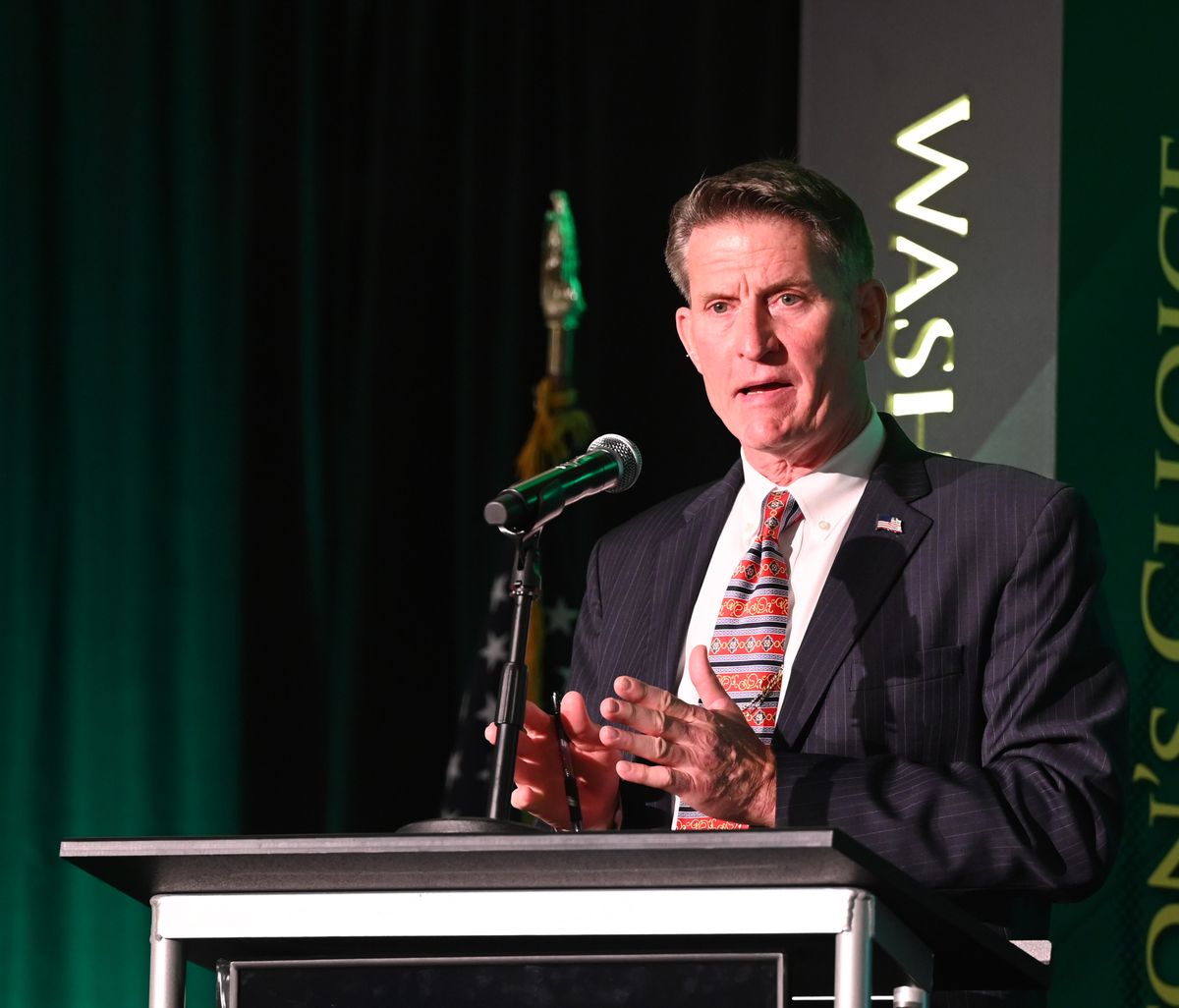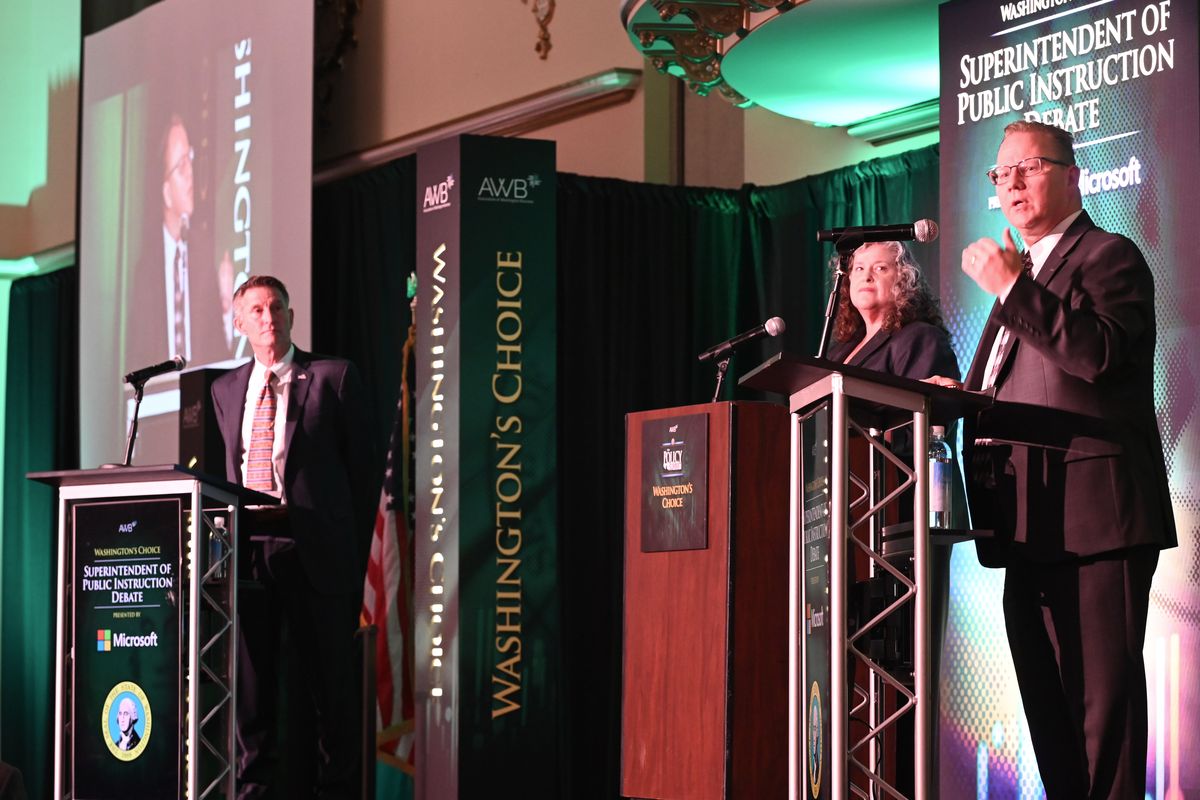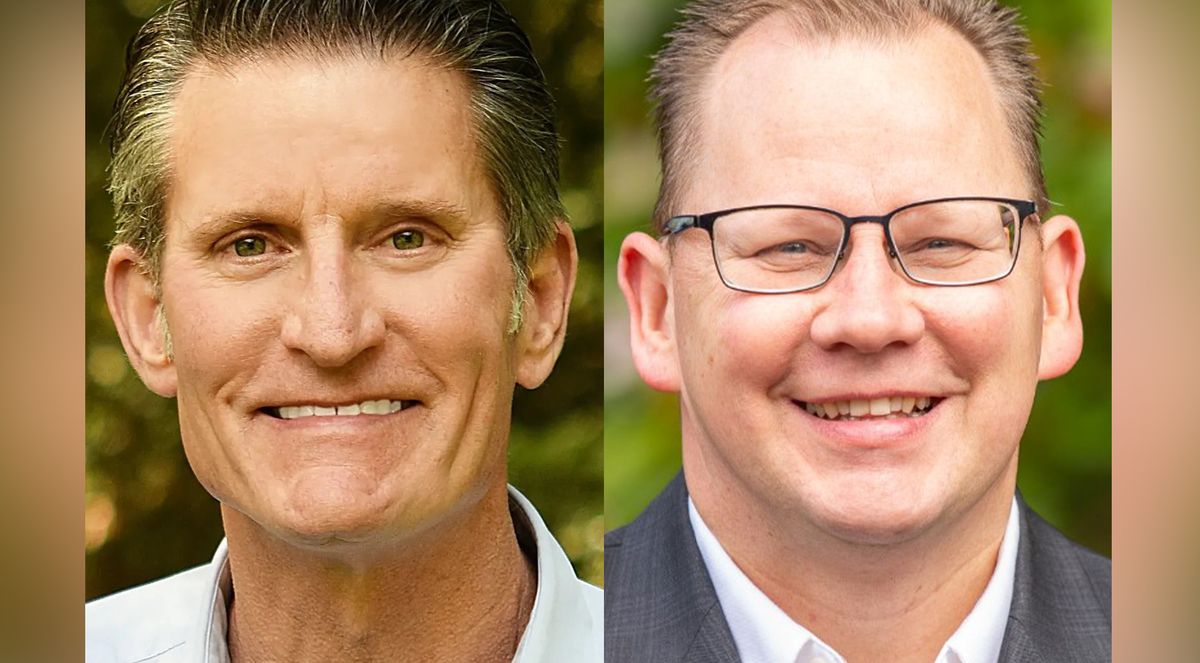Conservative challenger seeks to oust two-term incumbent to oversee Washington public schools
Chris Reykdal, the Washington state Superintendent of Public Instruction, debates opponent David Olson, left, in front of the meeting of the Association of Washington Business at the Davenport Hotel in Spokane on Wednesday, Sept. 18, 2024. (Jesse Tinsley/The Spokesman-Review)
Washington voters this year can grant a third term to State Superintendent of Public Instruction Chris Reykdal or fill the office with a fresh face to match newcomers who will fill at least four other statewide offices, including governor.
Ask either candidate in the superintendent race, they think they’ve got a shot at victory for the position that oversees state public school budgets, sets learning standards and issues guidance toward local schools.
The nonpartisan, elected position pays around $166,000 annually for a four-year term.
In the August primary, progressive incumbent Chris Reykdal claimed just under 39.5% of the vote, while conservative challenger David Olson earned around 31.4%. The two now vie for the some 520,000 votes received by progressive Reid Saaris and Libertarian John Patterson Blair.
A retired Navy diver, Olson has served for 11 years on the Peninsula School Board in Gig Harbor where he helped implement cellphone restrictions and passed a resolution against critical race theory.
In this office, he said, he’s watched public schools in Washington go in the “wrong direction” while under Reykdal’s leadership, especially surrounding student academic achievement.
“I just finally said as a school board member seeing the great things we’re doing and where I’m at compared to statewide, we’re not going in the right direction,” Olson said. “It’s that old adage, ‘You can either complain or step up and do something.’ I decided that I’m going to step up and do something.”
Olson has the endorsement of the state Republican Party.
Though Olson argues his military experience makes him well suited to lead the office and school board time keeps him in touch with local needs, Reykdal is steadfast that “experience matters,” and he has a more applicable resume than his challenger.
“I’ve had every role in education,” Reykdal said, listing roles from a kid in public school to working summers as a custodian to a public school teacher to working in the community and technical college system, as well as elected roles on a school board, in the state House of Representatives and finally as state superintendent.
“Having worked in schools, not just as a school board member, but also worked in schools and gone through public school in this state, not another state,” Reykdal said. “It’s the unique perspective of knowing what’s needed and how to listen to folks who have a perspective on what they still need. So that experience matters.”
Reykdal opposes charter school expansion and school vouchers that would allow parents to use state money to pay private school tuition.
Olson supports charter school expansion and boosting charter funding. He said he is open to starting a voucher program in Washington.
“I support options so I would say I would keep all my options open,” Olson said.
Both candidates say the Legislature should boost funding for special education and transportation. They also say they support moves by school districts to limit cellphone use. As a school board member, Olson cast a vote to ban cellphones in the Peninsula School District, a change he says is helping academics and mental health. Reykdal recently issued guidance for local school districts urging them to reduce cellphone use in class.
Top of mind in a race to head schools, Olson has been an outspoken critic of the state’s test scores and their reflection on Reykdal’s leadership, while Reykdal said the numbers accessed on his office’s report card aren’t understood. Olson touts his school district’s high test scores as an indicator he can bring the same successes to the 1.1 million students enrolled across the state.
Across the state, 50% of students met college -level readiness in English, 40% in math and around 44% science.
Reykdal argued that these numbers are often taken out of context, and don’t indicate the rates of kids meeting grade level standards, rather, the proportions of students ready to take a college-level course in that subject without needing a remedial class.
“Those are students who are achieving at a level that we expect to go to a selective university, take the highest level math and writing courses without needing any additional assistance,” Reykdal said. “So we more than produce enough students at that level who fill up our colleges and universities.”
Johnathan Curley
Johnathan Curley
Among the 9,000 pupils in Olson’s Peninsula School District, 66% met college -level readiness in English, 54% in math and 57% in science.
To help bring other districts up to the standards of Peninsula School District, Olson proposed incentivizing experienced teachers to work at high poverty schools and offer longer contracts to keep them at these schools. He’s also in favor of enticing bilingual teachers to move to communities with higher proportions of students needing instruction in another language.
“New teachers end up in those struggling school districts, and that often creates high turnover, so it’s hard for students to develop a relationship with a teacher,” Olson said.
In a September debate, governor hopefuls Republican Dave Reichart and Democrat Bob Ferguson both expressed support for changing the position of state superintendent from elected as it is now to appointed by the governor.
In Washington, the position has always been an elected one. Eleven other states operate with the election model for this office, while in 38 it’s a position appointed by the governor, state board of education or board of regents, depending on the state.
Reykdal argued for an appointed model but with a caveat. First, the Legislature should consolidate education policy agencies by eliminating those that set standards for teachers or requirements for graduation, for example.
This would create efficiency by granting these roles to the superintendent’s office and save spending on salaries within these bodies.
“Do we really need seven or eight executives, every one of them with their own government relations team, every one of them with their own communications directors?” Reykdal said. “It’s duplicative. It’s unnecessary. It diffuses the system to the point that even the best cooperation doesn’t actually create alignment.”
Only when this happens, Reykdal said, would he support an appointed superintendent. This would better hold the governor accountable to public education, something he said they often write off as a topic they’ve little control over.
Olson stood by the current model of an elected superintendent, arguing that it allows voters more flexibility to select an executive department that reflects their political leanings.
“We’ve had one political party in power here for 40 years, but the superintendent has been able to roll through, not always as the same party in power, because the voters can change that person out,” Olson said.
An elected position better holds the official accountable to the people they’re elected to, he said. Additionally, he said overseeing schools is too important to remove the people’s voice for that selection process.
“The voters, the parents, the teachers, should be able to vote that person out if they’re not performing well,” Olson said. “It’s too important, and it’s the future of our state.”
The shift of position away from elected to appointed is not something the superintendent or governor can solely accomplish. To do so would require an amendment to the Washington constitution, a task necessitating a two-thirds approval of both chambers in the Legislature and approval from Washington voters.



